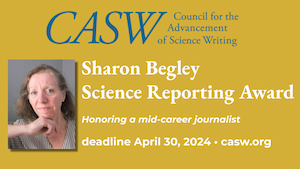By Rebecca Burton
Starting a blog for a university or institution requires convincing the higher-ups and sometimes breaking away from the serious tone that is common among research publications.

"Blogging for institutions" panel. Left to right: Henry Scowcroft, Carol Clark, Matt Shipman, Karen Kreeger. Photo by Rebecca Burton.
“Don’t think of it as a blog. Think of it as a really light, lean, and flexible web platform. When you pitch it, call it a really cheap way to disseminate information,” said Carol Clark, senior science communicator at Emory University and a panelist for Saturday’s session titled, “Blogging for institutions.”
Clark and the other three panelists — Karen Kreeger, senior science communications manager at Penn Medicine; Henry Scowcroft, news and multimedia manager for Cancer Research UK; and Matt Shipman, public information officer for North Carolina State University — all agreed that a blog is an inexpensive and efficient way to publish content that doesn’t fit into the traditional and formulaic press release.
“The blog gives you a great amount of narrative possibility and you can use that to reach out to reporters,” Shipman said.
Before jumping right in, communicators should first measure their time and resources, panelists said.
“If you won’t be able to do it well, you probably shouldn’t do it,” Shipman said.
Some panelists had slightly different opinions on how to execute a blogging plan. Shipman said communicators should know their audience and have very specific goals in mind. He also recommended stockpiling stories that aren’t time sensitive to keep content on reserve.
Scowcroft said although his team had objectives, they sort of “dove right in.”
“Start cheap and easy, get successful and then get money from your brand department to make it look cool,” he advised.
The panel also offered clever content ideas. Kreeger suggested asking scientists to contribute guest posts, adding an editorial twist to something the media is already covering, and posting expert Q&As. Buzzfeed-type “listicles” and video posts also proved to be successful for some of the panelists.
No matter the story format, the panel agreed that communicators should always approach the story as reporters, while still maintaining relationships with the researchers.
Finding a specific voice is just as important as content.
“If you’re trying to get everyone to write in the same tone, it’s probably not going to work very well,” Shipman said. “It’s OK to be conversational if you’re conversational. It’s so natural to write in your own voice. It delineates what you’re writing on the blog versus the main news site.”
Once the content is up, it’s time to promote it. Social media, building personal relationships with reporters, and sharing with other internal departments and federal funding agencies were just a few suggestions from the panelists.
“Find the partners that won’t only help you spread the messages, but will help you spread it to audiences that matter,” Shipman said.
At the end of the session, the panelists shared different techniques to track the success of their blogs. Using Google Analytics and page view statistics were pretty standard, but whether blog posts got picked up by influential news organizations seemed to hold more weight than the number of clicks they received.
“It’s important to look at the non-numeric stuff,” Scowcroft said. “Who is reading? Do they like it? How does it make them feel?”
Above all, the panelists all agreed that a blog shouldn’t be a burden, but a fun way to explain what researchers are doing.
“A blog is a good place to experiment with scientists letting their hair down,” Clark said.
A summary of all of the panelists’ tips and resources can be found at http://bit.ly/sciwri14orgblog.
.png)

